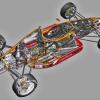How the hell do you manage to type, what with having 6 fingers and all - Ah you got a loight boiy?
Only because i am from Lancashire - Duckworth country actually.
Narfuk is as much a mystery to me as it is to the rest of you. Many's the time we have crossed the Narfuk 'frontier' near Mildenhall with England and wondered if we just keep on going. These days you don't even need an entry visa or passport to get in here , but it can be trickier to get out again, as no Sat Nav yet devised works here. This is because all the algorithmns inside one assume a road network consisting of motorways, dual carriageways, and heavily congested town centres. Use one here and you will find yourself driving through a lane 6' wide covered in cow pats with odd looking locals sitting on the verge chewing grass and trying to work out which model of Austin , Morris or Standard you are driving. And they will all be related... Consequently when out walking the dog you will get about 10' before a volvo towing a swift caravan pulls up next to you asking for directions. Every single one thinks they are the first to ask for them, i plan to get a sticker for my doggie walking coat which says "I do not give directions, I am not friendly, and I sometimes bite. The dog however is fine"
You can blame all of this on Colin Chapman (which will please at least one tnf member known to most of us), and his search from the air for a cheap, deserted airfield in 1965. Or maybe even Tony Rudd who suggested it to him?
It has its advantages. It's not generally known that Norfolk never actually joined the EU in the first place and so Brexit is an established fact here. You can still find local shops that will take £sd and everything is measured in feet and inches.
Likewise we are relatively untroubled by new technology, industry (of any kind), electricity, motorways, brick buildings and so on. But If you are into tractors, land rovers (series 1) or caravans this is the definately the place for you. Or Carrots. We have lots of carrots. And turnips. Usually spread over the A47.
One day i plan to reapply for my English citizenship and head back up to Lancs, if they will have me.























